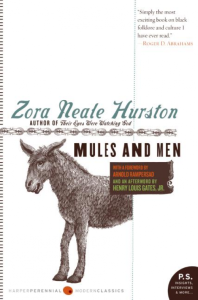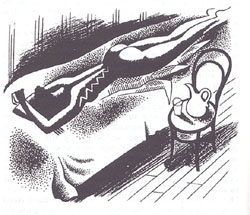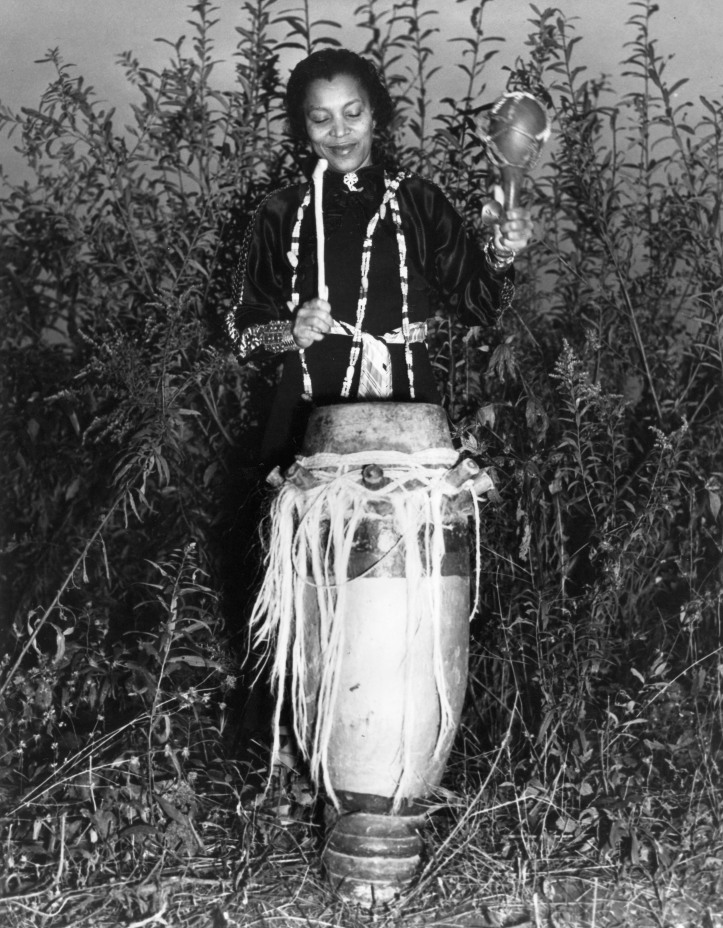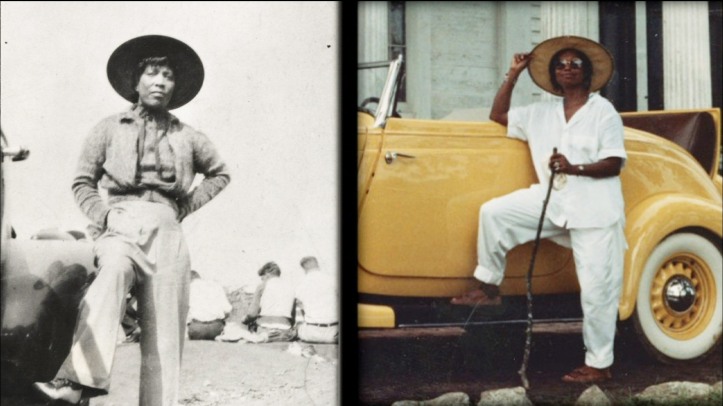Mules and Men by Zora Neale Hurston started as a project handed down from Hurston’s college mentor, professor of anthropology Franz Boas. She was to travel and research folk tales. Thus, Mules and Men is the result of what Hurston gathered from 1930-1932, but it wasn’t published until 1935. Hurston researched in her hometown, Eatonville (Florida), nearby communities, and New Orleans. That material, she admits, was a beast to stitch together into a rough draft. Thus, publishers originally couldn’t envision it as a book.
In it’s final form, the folk tales are organized by Hurston’s location instead of theme. The sentences are written almost entirely in Southern black dialect, so if you’re not practiced with it, or if English is not your first language, you’ll likely struggle. My copy, pictured below, comes with a lot of extra materials, too, including some illustrations by Miguel Covarrubias.

But is the final book cohesive? The main text is in two sections — Part I: Folk Tales (from Florida), and Part II: Hoodoo (from New Orleans). Both parts are tremendously different in tone and style. Sections of Part I are narrated in first-person, with Hurston inserting herself in her travels. Other times, she isn’t mentioned for chapters on end. We get a series of stories from the people she meets, who call their tales “lies.” These lies are indented from the rest of the text, so it’s clear on the page what’s happening. Some lies are why the snake has teeth and a rattle, or stories of John, a famous slave who always outsmarts his master. Part I reads like a series of narratives and is rich, hilarious, insightful.*
In Part II, everything is through Hurston’s eyes. The hoodoo doctors and their customers she meets are all clearly filtered through her, whereas an anthropological text typically steps back and has the writer observing without input. As a result, Part II reads more like the Zora Neale Hurston Instruction Manual of How-To Hoodoo. The writing style is almost entirely a list. Overall, Part II felt tacked on.**

Despite the divided feel to the book, it can be quite interesting. Part I demonstrates “the dozens” at its best. The dozens is a game played in black communities in which participants try to best each other with lies or insults. In my review of Dust Tracks on a Road, I mentioned Hurston’s experiences with folks trying to out-insult each other. The insults get more creative, more humorous. Though the dozens seems mean at times, it’s in good fun in this particular culture.
Hurston shares instances of people trying to convince a group of who knows the ugliest person, who lived through the hottest day ever, and who has the best gun. One man tells his friends that he knew a man so ugly, “he didn’t die — he jus’ uglied away.” It’s the rhythm of the exchanges that’s best. Typically, one person tells their lie, then another person tries to tell a better lie, starting by dismissing the previous lie: “Those men ya’ll been talkin’ ’bout wasn’t ugly at all. Those was pretty.” The liar proceeds to tell who they think is truly the ugliest and why. On and on it goes. The exchanges are hilarious, and the group laughs heartily along with the reader.

But Part II isn’t nearly as interesting. Hurston works her way around New Orleans to find hoodoo doctors. She meets many, and each make her go through an initiation ritual to prove she can assist the doctor. There are a lot of instructions for the initiations and for customers of the doctors, which I noticed I skimmed at times:
Use six red candles. Stick sixty pins in each candle — thirty on each side. Write the name of your sweetheart three times on a small square of paper and stick it underneath the candle. Burn one of these prepared candles each night for six nights. Make six slips of paper…. ETC.
The editors of Hurston’s book have, since her death, added extra materials, so many that they may overwhelm the reader. The book begins with a very short preface from her anthropology professor, Franz Boas, that is unnecessary because it gives nothing new. There’s a foreword by Arnold Rampersad that puts Hurston and her work in the context and discusses the integrity of Mules and Men from a research perspective, which I found helpful. Hurston had already included an introduction, though, making Rampersad’s addition repetitive. Finally, readers get to Hurston’s actual book. Part I: Folk Tales is 172 pages, but Part II: Hoodoo is a mere 63 pages. These should have been two different books.

At the end of the book, Hurston chose to include a glossary and appendix for things like “Negro Songs with Music” and “Paraphernalia of Conjure.” In footnotes throughout Parts I and II, Hurston writes, “See Appendix.” Which page? I couldn’t follow based on clues. Then, we get a selected bibliography of Hurston’s works, works about her, and a chronology of her life. Next, is the essay Alice Walker wrote and published in Ms. magazine in 1975 that re-introduced Hurston to the public.
Next, is the essay Alice Walker wrote and published in Ms. magazine in 1975 that re-introduced Hurston to the public. At the time, all of Hurston’s books were out of print. I giggled when I discovered that Alice Walker was mad that Zora Neale Hurston loved to eat and was 200lbs. Walker writes, “What! Zora was fat!”

Mules and Men also has an excerpt from Hurston’s biography. Finally, the text concludes with images of all the covers and synopses of her books. If you really want all sorts of information and tidbits, the extra materials will please you. I found a lot repeated, especially since I had already read Dust Tracks on a Road, but Alice Walker’s essay and Arnold Rampersad’s analysis/context were important pieces.
Mules and Men by Zora Neale Hurston can be a hilarious read at times, all while giving insight into 1930s Floridian black communities in the swamps. Yet, this collection struggles because it ultimately doesn’t know how to be what it wants to be.
Have you studied anthropology in school? Do you like all the extra materials that come in re-published books?
*Hurston’s second collection of nonfiction, Every Tongue Got to Confess, takes her back to the Gulf Coast states to gather more folk tales. The collection is organized differently: “Arranged according to subject — from God Tales, Preacher Tales, and Devil Tales to Heaven Tales, White-Folk Tales, and Mistaken Identity Tales…” I look forward to reviewing it later on Grab the Lapels.
**I also look forward to reading Tell My Horse, Hurston’s third nonfiction collection that focuses solely on hoodoo in Jamaica and Haiti.

Sounds fascinating. I’d not heard of Hurston before.
LikeLiked by 1 person
Most people encounter Their Eyes Were Watching God first. There was also a film version with Halle Berry. In fact, most people think if her as a story writer and are not aware that she studied anthropology.
LikeLike
At some point, Melanie laughed at something in the book and I had to ask what was so funny. She was in the bit wherein a group of people are lying about who knew the ugliest person and one claimed that they knew someone so ugly they fell in a river and one could skim ugly off that river for weeks afterward. Man. That’s pretty ugly.
LikeLiked by 1 person
I still like “he uglied away” better. The poor guy couldn’t even die properly, he was so ugly. 😂😂
LikeLike
I think books by people who were “there” are fascinating, much more interesting than historical reconstructions. These days it is fashionable for the author to put herself inside the frame, do you think Hurston was trying to do that, rather than setting up the usual academic/subject dichotomy?
LikeLiked by 1 person
I’m trying to think of an author who has done something similar today, and I can’t come up with any. I think Hurston was so influenced by her culture in Eatonville, Florida, that when she moved North and no one understood, she wanted to share what she learned. I’m not sure how she go into hoodoo, as that’s located in New Orleans, but I’ll find out in some of her other non-fiction work.
LikeLiked by 1 person
This collection sounds like an interesting look into the past. I’d never heard of it before!
LikeLiked by 1 person
Most people have at least heard of her novel Their Eyes Were Watching God, but most people don’t know she studied anthropology in college with one of the most famous anthropologists in the States!
LikeLike
A wonderful review, as always. I really appreciate the critical eye you use in examining Hurston’s work, but it’s obvious you respect the work a lot too. I didn’t study anthropology ever, sadly– but I think that’s why I love the extra parts in republished books. Heck, for any subject I’m not well-versed in, honestly. Reading the critique, essays, and praises of others often hone my own opinions to something more critical.
I agree with you that it sounds like Parts I and II should be separate books– that said, I wonder if part II would even have been *published* as a stand-alone. It sounds like Hurston was passionate about Hoodoo. Perhaps this was the only way to get this content published?
LikeLiked by 1 person
I think she was trying to show her patron what exactly happened in all that time she was being funded. The book is proof. On the other hand, perhaps she didn’t have confidence that she would get to write about hoodoo ever again (she did) because she had such a hard time getting this book published.
LikeLike
We read Their Eyes Were Watching God in college but I don’t think I understood how much more she had written or the anthropological background for her work, sounds fascinating yet vulnerable to being a lost part of history. Lovely to learn about.
LikeLike
Thanks so much for reaching, Jen! Do you remember if you liked her most famous novel, Their Eyes Were Watching God? I’ve both read it and listened to the audio version read by Ruby Dee, who did a fantastic job.
LikeLike
[…] this, but I knew that Hurston’s career as an anthropologist made me feel hesitant hesitant for other reasons. However, the biographer notes that Hurston never plagiarized […]
LikeLike
[…] Tongue Got to Confess different from Hurston’s other folk tale collections, such as Mules and Men, is that Hurston is completely absent. Readers wouldn’t even know she wrote the stories down […]
LikeLike
[…] while retaining the spirit of anthropology. She’s in the same boat at Zora Neale Hurston, who inserted herself into her own anthropological stories. While ethnography is more accessible, there are questions about its ethics. Regardless, Return to […]
LikeLike
[…] interested in Hurston but feeling hesitant. You get Hurston’s classic voice, full of idioms and humor. You’ll see parallels to folk tales that come out of the African American south that make […]
LikeLike
[…] Hurston is complicated. She was known for embellishing some of the stories folks told her for Mules and Men, another work of anthropology, to make the stories funnier or sharper. Also, there are a few places […]
LikeLike
[…] I really haven’t read much on Hurston, except Melanie/GTL on Hurston’s collections of Southern Black folk stories. But my impression at this point in my reading is that Hurston is a thoughtful and innovative […]
LikeLike